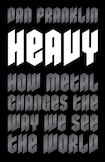
I recently went to a metal concert in Berlin with a distinguished English author. It was all billowing smoke, dark cloaks and clenched fists. Midway through he retreated to the bar, objecting to the music because it was ridiculous. I loved it because it was ridiculous. This indicates your likely response to Heavy, Dan Franklin’s paean to metal. If you’re happy to be swept along with Franklin’s take on songs such as Metallica’s Fight Fire with Fire (“It’s not so much with fear, but with relish, that [Hetfield] concludes each chorus: ‘We all shall die’ ”), you’ll have a ball.
Heavy, rather than presenting a history of metal, riffs on themes. The opening chapter, for example, covers the originators Black Sabbath, Led Zeppelin and Judas Priest; the next looks at metal as a response to nuclear war. Through this approach Franklin aims “to define what heavy music means to me, what it means to others, and how it binds other parts of culture to metal music”. Culturally nods are given to cinema, philosophy and the like in the casual, playful manner of a well-researched blog. Alongside this there’s not always a lot of critical analysis.
We read about Mayhem, the Norwegian group who burned down churches and imploded in murder and suicide
We read about Cradle of Filth, who pushed metal quite naturally towards gothic pornography. We read about Mayhem, the Norwegian group who, less agreeably, burned down churches and imploded in murder and suicide. We read about Sleep, whose magnum opus Dopesmoker – one immense hour-long song – imagines a caravan of “weedians or lungsmen” on a distant planet making a pilgrimage to the “riff-filled land”. Franklin notes the kinship with Rastafarianism.
Shocking filth
There’s much to savour. Has any other genre so excelled at band names? Morbid Angel, Cradle of Filth, Deicide, Anthrax, Bolt Thrower: just mentioning them creates an image (as with album titles, Paradise Gallows and Altars of Madness being two standouts). On the other hand, at its shallowest metal is shocking for the sake of it. But maybe that’s enough. Cradle of Filth’s brave career opening gambit – the slogan Jesus is a c**t – may not quite be Rilke, but you’re not going to forget it in a hurry. Franklin relishes these high jinks. The band’s local T-shirt printer in Suffolk refused to print the blasphemous slogan. Observes Franklin: “It was bad enough without the full-length photographic image of a naked, masturbating nun that covered the front.”
A repeated theme is metal's weird similarity to opera, that other art of po-faced ridiculousness and rarefied vocals
There are some corking lines. “Holmes [singer with Bloodbath] watched hundreds of horror films a year to feed a subconscious hungry for rotten lyrical fodder,” we learn (kids, don’t try this at home). A repeated theme is metal’s weird similarity to opera, that other art of po-faced ridiculousness and rarefied vocals. Wagner scholar John Deathridge is regularly called upon, though having studied under Deathridge I can attest he’s no Lawnmower Death fan. On a related note, might it be time to declare a moratorium on books having Nietzsche epigraphs? At this stage poor Nietzsche’s become the Bonnie Greer of philosophy, wheeled out for any and every occasion.
Classist snobbery
Those unconvinced by metal as an artform often point to its vocals. And I admit, once the revelation hits you that metal’s characteristic vocal style sounds like the Cookie Monster from Sesame Street, it’s hard to unhear it. To dispel such cynicism, the main weapon in Franklin’s arsenal, as well as formidable metal knowledge, is his infectious enthusiasm. On the other hand, here and there I missed a more left-field view. In describing Judas Priest’s penchant for leather and studs, Franklin only notes in passing the commonality with the idealised male in the gay leather scene. Similarly more attention could be given to how metal started as a working class art-form; snobbery against it is usually class snobbery.
In the last analysis, do songs such as Ulver’s Wanderer in This Infernal Night (Hymne III: Of Wolf and Hatred) drown us in illusion or does their mythic imagination touch on the deeper essence of life? Franklin has no doubt. “Heavy music takes us to the farthest shore of the human experience,” he concludes. “Once there, it invites us to look into the darkness, and give it our name.”
For the disaffected youth in your life, whatever their age, it will go down a treat
Critically analysing a book like this, I feel like a killjoy, but I am a musicologist, so . . . Tethering his book to the heavy thesis (metal is the art of heaviness) doesn’t allow Franklin to explore how often metal’s strongest quality is actually its levity: the music’s buoyant dark carnival, a flow of masks intensifying the ridiculous situation of being alive. Credo quia absurdum, went an old Christian tenet: “I believe because it is absurd.” So it is with metal.
Small caveats aside, Heavy is tremendously entertaining, and it will have you rushing to YouTube to educate yourself on Primitive Man and company. For the disaffected youth in your life, whatever their age, it will go down a treat.








